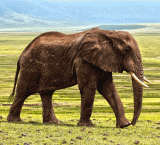
Elephant
Overview
Elephants are large land mammal
s in two extant genera
of the family
Elephantidae
: Elephas
and Loxodonta
, with the third genus Mammuthus
extinct. Three species
of elephant are recognized: the African bush elephant
, the African forest elephant
and the Indian or Asian elephant
; although some group the two African species into one and some researchers also postulate the existence of a fourth species in West Africa. All other species and genera of Elephantidae are extinct
. Most have been extinct since the last ice age
, although dwarf forms of mammoth
s might have survived as late as 2,000 BCE.
Mammal
Mammals are members of a class of air-breathing vertebrate animals characterised by the possession of endothermy, hair, three middle ear bones, and mammary glands functional in mothers with young...
s in two extant genera
Genus
In biology, a genus is a low-level taxonomic rank used in the biological classification of living and fossil organisms, which is an example of definition by genus and differentia...
of the family
Family (biology)
In biological classification, family is* a taxonomic rank. Other well-known ranks are life, domain, kingdom, phylum, class, order, genus, and species, with family fitting between order and genus. As for the other well-known ranks, there is the option of an immediately lower rank, indicated by the...
Elephantidae
Elephantidae
Elephantidae is a taxonomic family, collectively elephants and mammoths. These are terrestrial large mammals with a trunk and tusks. Most genera and species in the family are extinct...
: Elephas
Elephas
Elephas is one of two surviving genera in the order of elephants, Proboscidea. The genus has one surviving species, the Asian elephant Elephas maximus....
and Loxodonta
Loxodonta
African elephants are the species of elephants in the genus Loxodonta , one of the two existing genera in Elephantidae. Although it is commonly believed that the genus was named by Georges Cuvier in 1825, Cuvier spelled it Loxodonte...
, with the third genus Mammuthus
Mammoth
A mammoth is any species of the extinct genus Mammuthus. These proboscideans are members of Elephantidae, the family of elephants and mammoths, and close relatives of modern elephants. They were often equipped with long curved tusks and, in northern species, a covering of long hair...
extinct. Three species
Species
In biology, a species is one of the basic units of biological classification and a taxonomic rank. A species is often defined as a group of organisms capable of interbreeding and producing fertile offspring. While in many cases this definition is adequate, more precise or differing measures are...
of elephant are recognized: the African bush elephant
African Bush Elephant
The African Bush Elephant or African Savanna Elephant is the larger of the two species of African elephant. Both it and the African Forest Elephant have usually been classified as a single species, known simply as the African Elephant...
, the African forest elephant
African Forest Elephant
The African Forest Elephant is a forest dwelling elephant of the Congo Basin. Formerly considered either a synonym or a subspecies of the African Savanna Elephant , a 2010 study established that the two are distinct species...
and the Indian or Asian elephant
Asian Elephant
The Asian or Asiatic elephant is the only living species of the genus Elephas and distributed in Southeast Asia from India in the west to Borneo in the east. Three subspecies are recognized — Elephas maximus maximus from Sri Lanka, the Indian elephant or E. m. indicus from mainland Asia, and E. m....
; although some group the two African species into one and some researchers also postulate the existence of a fourth species in West Africa. All other species and genera of Elephantidae are extinct
Extinction
In biology and ecology, extinction is the end of an organism or of a group of organisms , normally a species. The moment of extinction is generally considered to be the death of the last individual of the species, although the capacity to breed and recover may have been lost before this point...
. Most have been extinct since the last ice age
Ice age
An ice age or, more precisely, glacial age, is a generic geological period of long-term reduction in the temperature of the Earth's surface and atmosphere, resulting in the presence or expansion of continental ice sheets, polar ice sheets and alpine glaciers...
, although dwarf forms of mammoth
Mammoth
A mammoth is any species of the extinct genus Mammuthus. These proboscideans are members of Elephantidae, the family of elephants and mammoths, and close relatives of modern elephants. They were often equipped with long curved tusks and, in northern species, a covering of long hair...
s might have survived as late as 2,000 BCE.
Unanswered Questions
Discussions

